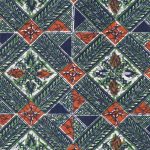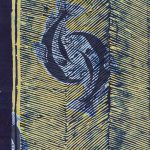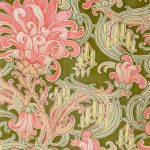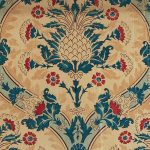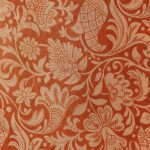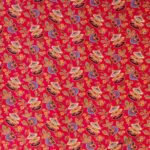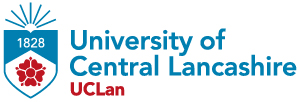This commercial sample was designed and manufactured in Lancashire using industrial printing processes to closely imitate the effect of a traditional, hand worked batik or wax resist dyeing. It was produced by the Manchester based firm Edwards, Cunliffe & Co Ltd c.1950-60 and was intended for the African export market. A manufacturer’s label still attached […]
View moreThis sample is one of a set of over 90 print samples attributed to the Robert Hindle & Co Print Works in Sabden, Lancashire. The vibrant colours of the samples are a perfect example of the impact that aniline dyes had on the dyeing and printing industries. The first aniline dye was mauveine or ‘Perkin’s […]
View moreThis sample is one of a set of over 90 print samples attributed to the Robert Hindle & Co Print Works in Sabden, Lancashire. The vibrant colours of the samples are a perfect example of the impact that aniline dyes had on the dyeing and printing industries. The first aniline dye was mauveine or ‘Perkin’s […]
View moreThis sample is one of a set of over 90 print samples attributed to the Robert Hindle & Co Print Works in Sabden, Lancashire. The vibrant colours of the samples are a perfect example of the impact that aniline dyes had on the dyeing and printing industries. The first aniline dye was mauveine or ‘Perkin’s […]
View moreThis adire cloth was produced in Ibadan, Nigeria, and uses cassava starch paste as a resist to create the pattern using indigo dye. The technique is similar to other resist techniques such as batik, but using cassava starch instead of wax. This sample is now held in the Gawthorpe Textiles Collection but was originally collected […]
View moreA commercial sample of a furnishing weight cotton chintz with an Art Nouveau style pattern designed by Samuel Rowe and printed by Turnbull & Stockdale Ltd. The stylised, intricate and sinuous forms of the flowers in this design are typical of the evolving styles at the end of the 19th century, when Arts & Crafts […]
View moreThis sample of glazed cotton cretonne furnishing fabric was designed by Lewis Foreman Day (b.1845 d.1910). Day was an influential designer, critic and artist who combined the design principles of the Arts & Crafts Movement with industrial production methods. From the 1870s to his death in 1910 he was Artistic Director of the printing firm […]
View moreLightweight cotton furnishing fabric called ‘Salangore’, designed by Thomas Wardle for Liberty. The Victoria & Albert Museum has a sample of this design in blue, printed onto tussah silk hand-woven in India, which was exhibited in the British India Pavilion of the Paris Universal Exhibition of 1878. One of six Indian-inspired patterns at the exhibition, […]
View moreThis cloth was manufactured in Manchester for export to African markets. Depicted in the design is Moïse Tshombe, a Congolese businessman and politician who became president of the Secessionist state of Katanga from 1960 to 1963 and then Prime Minister of the Democratic Republic of the Congo 1964 to 1965. The style of the design […]
View moreThis yellow brocaded silk was probably intended for use as garment fabric – perhaps as a woman’s gown or a man’s coat or waistcoat. The silk has a damask weave creating a self-coloured background pattern overlaid with vibrant, colourful floral sprays that have been added with additional brocade weaving. The brocade is further enhanced with […]
View moreThis piece of roller printed cotton has a stylised floral pattern with a slight paisley influence, seen especially in the small patterns used as fillings for larger shapes. The small scale of the printed pattern and light-weight cotton fabric indicate this was probably intended for use as a dress fabric, although this length appears to […]
View moreThis commercial sample still has an unknown manufacturer’s label attached to the top edge, along with three swatches showing the same design on different coloured backgrounds. The complex and stylised floral pattern borrows heavily from Indian chintz designs but uses a colour palette more contemporary to the late 19th century; incorporating a lot more green […]
View more